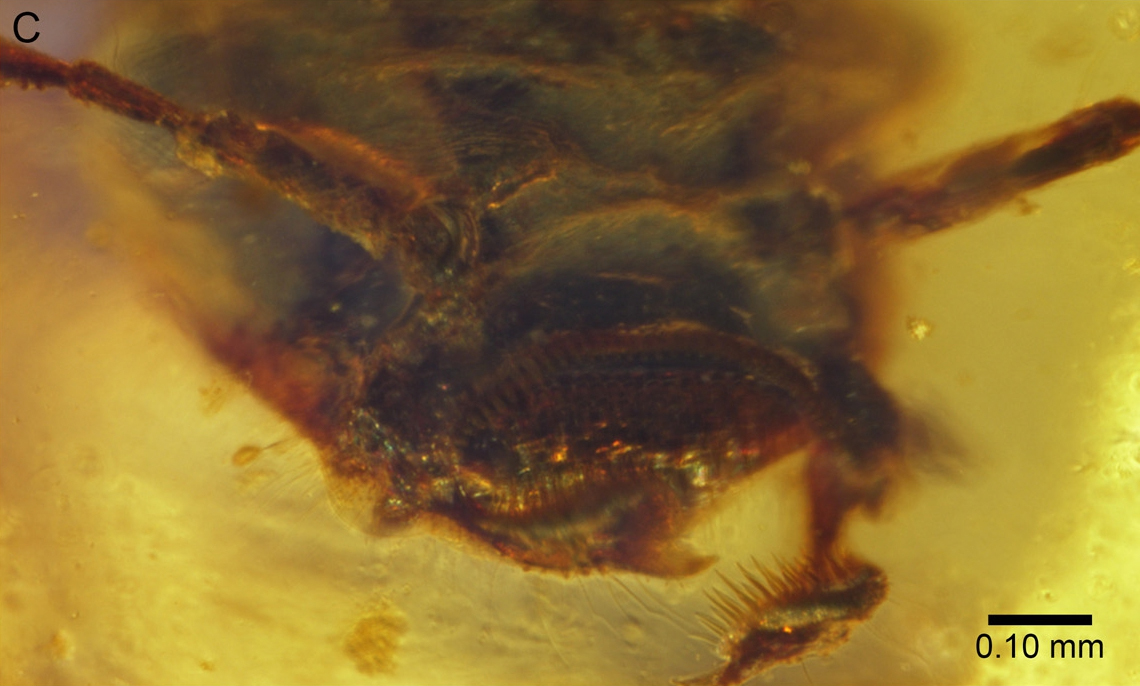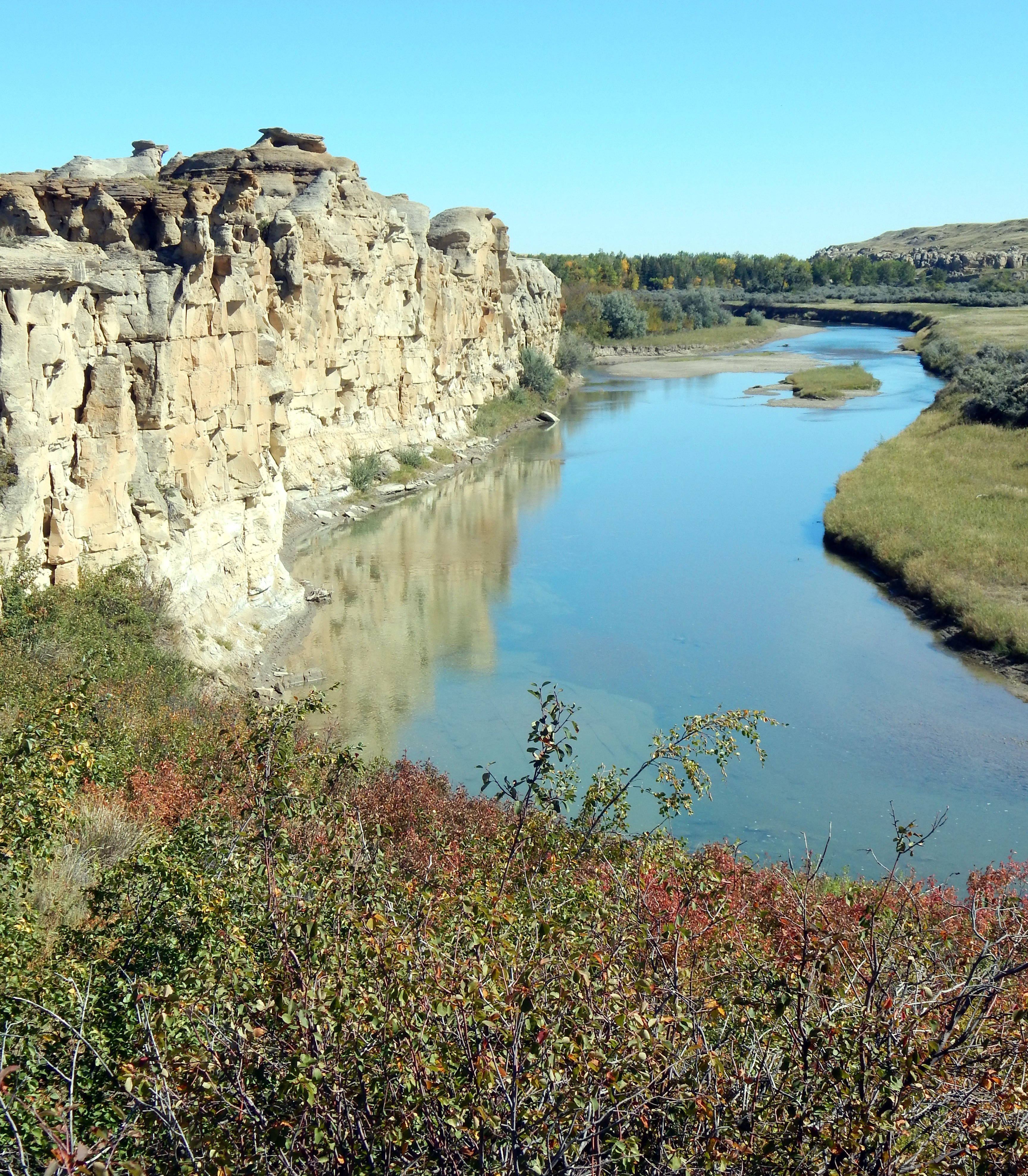|
Boltonimecia
''Boltonimecia'' is an extinct genus of ant in the formicid subfamily Zigrasimeciinae. The genus contains a single described species, ''Boltonimecia canadensis'', and is known from a single Late Cretaceous fossil which was found in Canada. The type species was originally described as a species of the extinct genus '' Sphecomyrma'' under the combination ''Sphecomyrma canadensis''. History and classification ''Boltonimecia'' is known from a single adult fossil, the holotype, specimen number "CAS 330" entombed in an amber chunk. At the time of the genus description, the specimen was residing in the Canadian National Collection of Insects, Arachnids and Nematodes, in Ottawa, Canada. The described specimen is of a worker caste adult which has been preserved as an inclusion in a transparent orange chunk of Canadian amber. The amber specimen was recovered ''in situ'' from the Taber coal zone near the top of Foremost Formation around Grassy Lake which is near Medicine Hat, Albe ... [...More Info...] [...Related Items...] OR: [Wikipedia] [Google] [Baidu] |
Zigrasimeciinae
Zigrasimeciinae is a subfamily of ants, known from the Cretaceous period, originally named as the tribe Zigrasimeciini within the subfamily Sphecomyrminae by Borysenko, 2017, it was elevated to full subfamily in 2020. It contains three described genera. They are sometimes known as "iron-maiden ants" in reference to their densely spiked mouthparts, reminiscent of an iron maiden torture device, that were likely used to trap prey. ''Boltonimecia canadensis'' was described from Campanian Canadian amber out of Alberta, Canada, while the species of '' Protozigrasimecia'' and ''Zigrasimecia'' are both exclusively known from Cenomanian Burmese amber found in Myanmar. Genera and species * ''Boltonimecia'' ** ''B. canadensis'' *'' Protozigrasimecia'' ** ''P. chauli'' * ''Zigrasimecia ''Zigrasimecia'' is an extinct genus of ants which existed in the Cretaceous period approximately 98 million years ago. The first specimens were collected from Burmese amber in Kachin State, west ... [...More Info...] [...Related Items...] OR: [Wikipedia] [Google] [Baidu] |
Zigrasimecia Ferox JWJ-Bu18a Head Closeup
''Zigrasimecia'' is an extinct genus of ants which existed in the Cretaceous period approximately 98 million years ago. The first specimens were collected from Burmese amber in Kachin State, west of Myitkyina town in Myanmar. In 2013, palaeoentomologists Phillip Barden and David Grimaldi published a paper describing and naming ''Zigrasimecia tonsora''. They described a dealate female with unusual features, notably the highly specialized mandibles. Other features include large ocelli, short scapes, 12 antennomeres, small eyes, and a clypeal margin that has a row of peg-like denticles. The genus ''Zigrasimecia'' was originally ''incertae sedis'' (uncertain placement) within Formicidae until a second species, ''Zigrasimecia ferox'', was described in 2014, leading to its placement in the subfamily Sphecomyrminae. Later, it was considered to belong to the distinct subfamily Zigrasimeciinae. Due to the highly specialized mandibles, scientists believe that the ants exhibited habits ... [...More Info...] [...Related Items...] OR: [Wikipedia] [Google] [Baidu] |
Zigrasimecia
''Zigrasimecia'' is an extinct genus of ants which existed in the Cretaceous period approximately 98 million years ago. The first specimens were collected from Burmese amber in Kachin State, west of Myitkyina town in Myanmar. In 2013, palaeoentomologists Phillip Barden and David Grimaldi published a paper describing and naming ''Zigrasimecia tonsora''. They described a dealate female with unusual features, notably the highly specialized mandibles. Other features include large ocelli, short scapes, 12 antennomeres, small eyes, and a clypeal margin that has a row of peg-like denticles. The genus ''Zigrasimecia'' was originally ''incertae sedis'' (uncertain placement) within Formicidae until a second species, ''Zigrasimecia ferox'', was described in 2014, leading to its placement in the subfamily Sphecomyrminae. Later, it was considered to belong to the distinct subfamily Zigrasimeciinae. Due to the highly specialized mandibles, scientists believe that the ants exhibited habit ... [...More Info...] [...Related Items...] OR: [Wikipedia] [Google] [Baidu] |
Foremost Formation
The Foremost Formation is a formation (stratigraphy), stratigraphic unit of Late Cretaceous (Campanian) age that underlies much of southern Alberta, Canada. It was named for outcrops in Chin Coulee near the town of Foremost, Alberta, ForemostGlass, D.J. (editor) 1997. Lexicon of Canadian Stratigraphy, vol. 4, Western Canada including eastern British Columbia, Alberta, Saskatchewan and southern Manitoba. Canadian Society of Petroleum Geologists, Calgary; 1423 p. on CD. . and is known primarily for its dinosaur remains and other fossils.Weishampel, David B; et al. (2004). "Dinosaur distribution (Late Cretaceous, North America)." In: Weishampel, David B.; Dodson, Peter; and Osmólska, Halszka (eds.): The Dinosauria, 2nd, Berkeley: University of California Press, pp. 574-588. . Geology The Foremost Formation is the basal unit of the Belly River Group (called the Judith River Group in the United States). It gradationally overlies the marine shales of the Pakowki Formation. It consists ... [...More Info...] [...Related Items...] OR: [Wikipedia] [Google] [Baidu] |
Campanian
The Campanian is the fifth of six ages of the Late Cretaceous Epoch on the geologic timescale of the International Commission on Stratigraphy (ICS). In chronostratigraphy, it is the fifth of six stages in the Upper Cretaceous Series. Campanian spans the time from 83.6 (± 0.2) to 72.1 (± 0.2) million years ago. It is preceded by the Santonian and it is followed by the Maastrichtian. The Campanian was an age when a worldwide sea level rise covered many coastal areas. The morphology of some of these areas has been preserved: it is an unconformity beneath a cover of marine sedimentary rocks. Etymology The Campanian was introduced in scientific literature by Henri Coquand in 1857. It is named after the French village of Champagne in the department of Charente-Maritime. The original type locality was a series of outcrop near the village of Aubeterre-sur-Dronne in the same region. Definition The base of the Campanian Stage is defined as a place in the stratigraphic column wher ... [...More Info...] [...Related Items...] OR: [Wikipedia] [Google] [Baidu] |
Antenna (biology)
Antennae ( antenna), sometimes referred to as "feelers", are paired appendages used for sensing in arthropods. Antennae are connected to the first one or two segments of the arthropod head. They vary widely in form but are always made of one or more jointed segments. While they are typically sensory organs, the exact nature of what they sense and how they sense it is not the same in all groups. Functions may variously include sensing touch, air motion, heat, vibration (sound), and especially smell or taste. Antennae are sometimes modified for other purposes, such as mating, brooding, swimming, and even anchoring the arthropod to a substrate. Larval arthropods have antennae that differ from those of the adult. Many crustaceans, for example, have free-swimming larvae that use their antennae for swimming. Antennae can also locate other group members if the insect lives in a group, like the ant. The common ancestor of all arthropods likely had one pair of uniramous (unbranched ... [...More Info...] [...Related Items...] OR: [Wikipedia] [Google] [Baidu] |
Crocodylian
Crocodilia (or Crocodylia, both ) is an order of mostly large, predatory, semiaquatic reptiles, known as crocodilians. They first appeared 95 million years ago in the Late Cretaceous period (Cenomanian stage) and are the closest living relatives of birds, as the two groups are the only known survivors of the Archosauria. Members of the order's total group, the clade Pseudosuchia, appeared about 250 million years ago in the Early Triassic period, and diversified during the Mesozoic era. The order Crocodilia includes the true crocodiles (family Crocodylidae), the alligators and caimans (family Alligatoridae), and the gharial and false gharial (family Gavialidae). Although the term 'crocodiles' is sometimes used to refer to all of these, crocodilians is a less ambiguous vernacular term for members of this group. Large, solidly built, lizard-like reptiles, crocodilians have long flattened snouts, laterally compressed tails, and eyes, ears, and nostrils at the top of the ... [...More Info...] [...Related Items...] OR: [Wikipedia] [Google] [Baidu] |
Test (biology)
In biology, a test is the hard shell of some spherical marine animals and protists, notably sea urchins and microorganisms such as testate foraminiferans, radiolarians, and testate amoebae. The term is also applied to the covering of scale insects. The related Latin term testa is used for the hard seed coat of plant seeds. Etymology The anatomical term "test" derives from the Latin ''testa'' (which means a rounded bowl, amphora or bottle). Structure The test is a skeletal structure, made of hard material such as calcium carbonate, silica, chitin or composite materials. As such, it allows the protection of the internal organs and the attachment of soft flesh. In sea urchins The test of sea urchins is made of calcium carbonate, strengthened by a framework of calcite monocrystals, in a characteristic "stereomic" structure. These two ingredients provide sea urchins with a great solidity and a moderate weight, as well as the capacity to regenerate the mesh from the cuticle ... [...More Info...] [...Related Items...] OR: [Wikipedia] [Google] [Baidu] |
Foraminiferan
Foraminifera (; Latin for "hole bearers"; informally called "forams") are single-celled organisms, members of a phylum or class of amoeboid protists characterized by streaming granular ectoplasm for catching food and other uses; and commonly an external shell (called a "test") of diverse forms and materials. Tests of chitin (found in some simple genera, and Textularia in particular) are believed to be the most primitive type. Most foraminifera are marine, the majority of which live on or within the seafloor sediment (i.e., are benthic), while a smaller number float in the water column at various depths (i.e., are planktonic), which belong to the suborder Globigerinina. Fewer are known from freshwater or brackish conditions, and some very few (nonaquatic) soil species have been identified through molecular analysis of small subunit ribosomal DNA. Foraminifera typically produce a test, or shell, which can have either one or multiple chambers, some becoming quite elaborate in struc ... [...More Info...] [...Related Items...] OR: [Wikipedia] [Google] [Baidu] |
Ceratopogonidae
Ceratopogonidae is a family of flies commonly known as no-see-ums, or biting midges, generally in length. The family includes more than 5,000 species, distributed worldwide, apart from the Antarctic and the Arctic. Ceratopogonidae are holometabolous, meaning their development includes four life stages: egg, larva, pupa, and imago or adult. Most common species in warmer climates will take about two to six weeks to complete a life cycle. Both adult males and females feed on nectar. Most females also feed on the blood of vertebrates, including humans, to get protein for egg-laying. Their bites are painful, and can cause intensely itchy lesions. Their mouthparts are well-developed for cutting the skin of their hosts. Some species prey on other insects. Larvae need moisture to develop, but also air and food. They are not strictly aquatic or terrestrial. Some species within the biting midges are thought to be predatory on other small insects. Particularly mosquito larvae have been ... [...More Info...] [...Related Items...] OR: [Wikipedia] [Google] [Baidu] |
Western Interior Seaway
The Western Interior Seaway (also called the Cretaceous Seaway, the Niobraran Sea, the North American Inland Sea, and the Western Interior Sea) was a large inland sea that split the continent of North America into two landmasses. The ancient sea, which existed from the early Late Cretaceous (100 million years ago) to the earliest Paleocene (66 Ma), connected the Gulf of Mexico, through the United States and Canada, to the Arctic Ocean. The two land masses it created were Laramidia to the west and Appalachia to the east. At its largest extent, it was deep, wide and over long. Origin and geology By Late-Cretaceous times, Eurasia and the Americas had separated along the south Atlantic, and subduction on the west coast of the Americas had commenced, resulting in the Laramide orogeny, the early phase of growth of the modern Rocky Mountains. The Western Interior Seaway may be seen as a downwarping of the continental crust ahead of the growing Laramide/Rockies mountain chain. Th ... [...More Info...] [...Related Items...] OR: [Wikipedia] [Google] [Baidu] |







